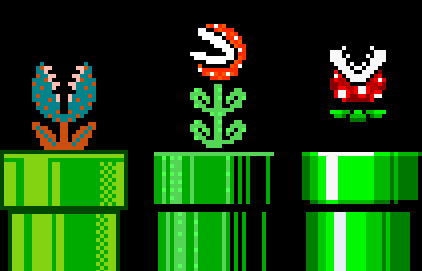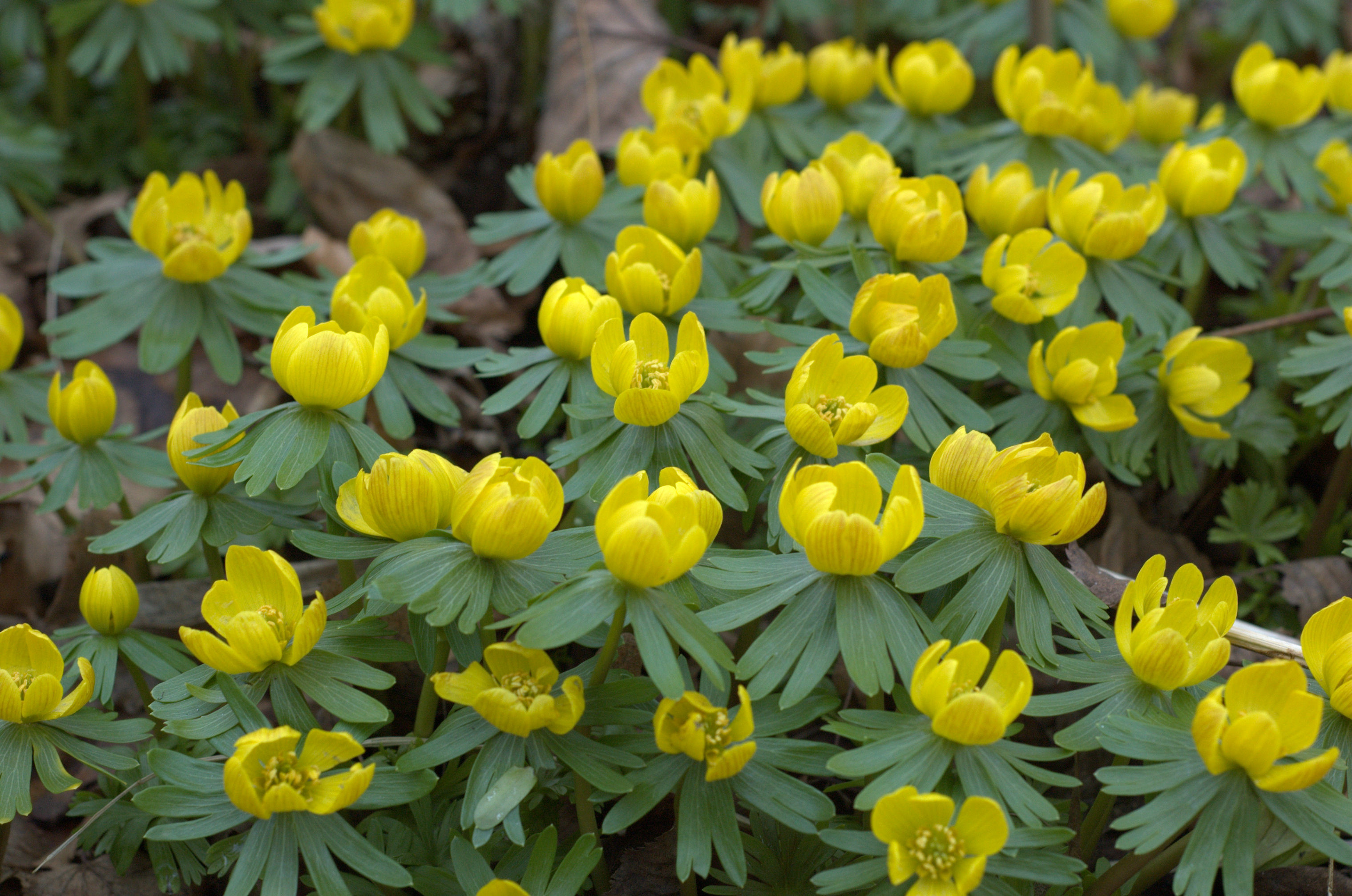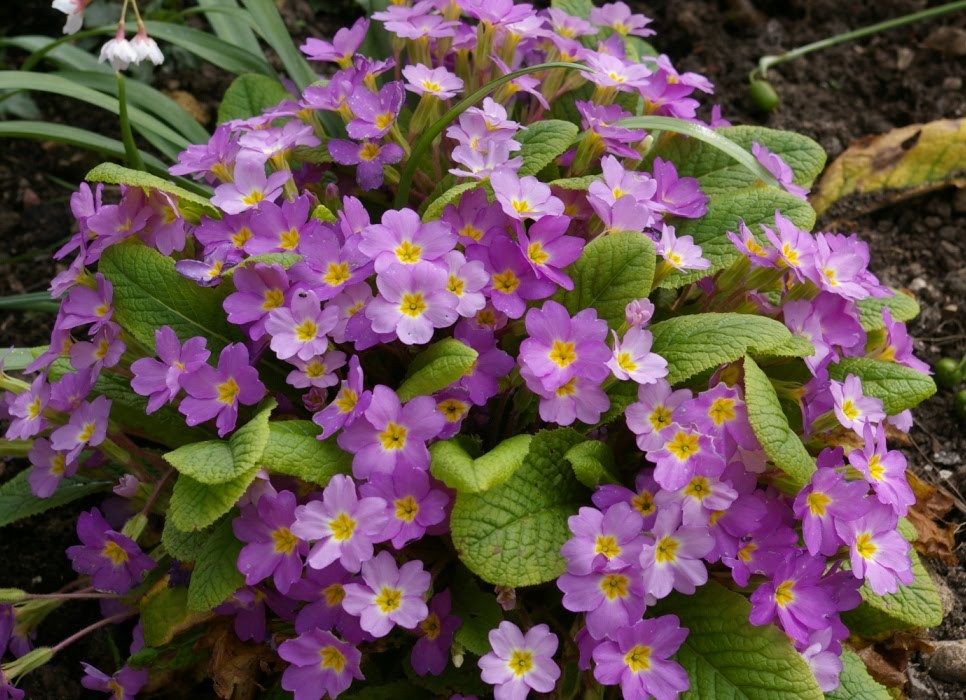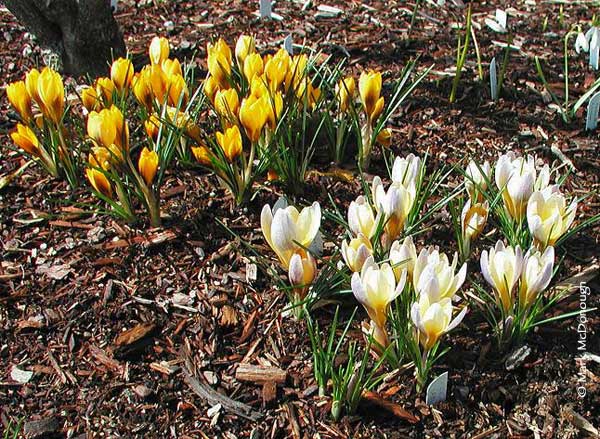Latin Name: Eranthis hyemalis
Common Name: winter aconite
Family: Ranunculaceae
Origin: Southern France to Bulgaria
Tree/Shrub/Herb: Herbaceous perennial
Form: Low, erect
Habit: Clump forming
Leaves: Whorled around the stem just below infloresence, linear
Flowers: Yellow, 6 petals, cup-shaped
Cultural Requirements: Full sun to partial shade, moist, well drained, organic soil
Landscape Uses: Early spring colour
Notes: Poisonous if consumed
Latin Name: Galanthus elwesii
Common Name: snowdrop
Family: Amaryllidaceae
Origin: Europe
Tree/Shrub/Herb: Herbaceous perennial
Form: Vaselike
Habit: Erect
Leaves: Simple, basal, glabrous, parallel veination, broader than G. nivalis
Flowers: Solitary flowers, perfect, 3 petals
Cultural Requirements: Partial sun, well drain, moist soil
Landscape Uses: Early season flowering bulb for late winter interest in shady areas
Notes: Prized by collectors for different patterning of green stripes on petals
Latin Name: Galanthus nivalis
Common Name: snowdrop
Family: Amaryllidaceae
Origin: Europe
Tree/Shrub/Herb: Herbaceous perennial
Form: Vaselike
Habit: Erect
Leaves: Simple, basal, glabrous, parallel veination, thinner than G. elwesii
Flowers: Solitary flowers, perfect, 3 petals
Cultural Requirements: Partial sun, well drain, moist soil
Landscape Uses: Early season flowering bulb for late winter interest in shady areas
Notes: Prized by collectors for different patterning of green stripes on petals
Latin Name: Iris ‘Katharine Hodgkin’
Common Name: iris Katherine Hodgkin
Family: Iridaceae
Origin: Garden origin
Tree/Shrub/Herb: Herbaceous perennial
Form: Vaselike
Habit: Open
Leaves: Linear, parallel veination
Flowers: Blue with yellow/white/black centre
Cultural Requirements: full sun, moist, well drained soil
Landscape Uses: Early spring colour
Notes: Flowers appear before foliage in late winter/early spring
Latin Name: Iris reticulata
Common Name: dwarf iris
Family: Iridaceae
Origin: Asia Minor
Tree/Shrub/Herb: Herbaceous perennial
Form: Mounded
Habit: Upright
Leaves: Simple, basal, flat, parallel veination
Flowers: Solitary, campanulate, purple with yellow splash
Cultural Requirements: Full sun, well drained, moist soil
Landscape Uses: Early season flowering bulb for late winter interest in shady areas
Notes: Flowers February and into March
Latin Name: Narcissus asturiensis
Common Name: daffodil
Family: Amaryllidaceae
Origin: Mountainous areas of north Portugal and Spain
Tree/Shrub/Herb: Herbaceous perennial
Form: Upright with drooping head
Habit: Clump forming
Leaves: Linear, pale green, basal
Flowers: Yellow, tighter inner cup of petals with slaying outer sepals
Cultural Requirements: Full sun, moist, well drained, moderately rich soil
Landscape Uses: Early spring colour
Notes: Natural grows at high elevations (2000m)
Latin Name: Primula vulgaris subsp. sibthorpii
Common Name: primrose
Family: Primulaceae
Origin: Europe, North Africa, SW Asia
Tree/Shrub/Herb: Herbaceous perennial
Form: Round
Habit: Dense
Leaves: Simple, basal, glabrous, obovate
Flowers: Solitary, 5 petalous, many colours
Cultural Requirements: Full sun to part shade, moist soil (especially in sunnier spots), well drained
Landscape Uses: Early spring colour
Latin Name: Rhododendron dauricum
Common Name: Dahurian rhododendron
Family: Ericaceae
Origin: Siberia, Mongolia, China, Japan
Tree/Shrub/Herb: Evergreen shrub
Form: Rounded
Habit: Upright, multi-stemmed
Leaves: Small, ovoid, lighter underneath
Flowers: Pink to purple, terminal, funnel shaped
Stem/Bark: Light brown bark
Cultural Requirements: Partial shade to full sun, moist, well drained soil
Landscape Uses: Early spring colour
Notes: This is a lepidote
Latin Name: Salix gracilistyla ‘Melanostachys’
Common Name: black willow
Family: Salicaceae
Origin: Japan, Korea, China
Tree/Shrub/Herb: Deciduous shrub
Form: Sprawling
Habit: Dense, thicket forming
Leaves: Lanceolate, linear, parallel veination
Flowers: Black male and female catkins, males have red anthers and yellow pollen
Stem/Bark: Brown peeling bark
Cultural Requirements: Full sun, moist to wet soil
Landscape Uses: Winter interest, black colour contrast
Notes: Growns to 1-6m tall
Latin Name: Camellia ‘Michael’
Common Name: camellia Michael
Family: Theaceae
Origin: Garden origin
Tree/Shrub/Herb: Evergreen shrub
Form: Upright, arbourescent
Habit: Irregular branching
Leaves: Ovate, pointed apex, dark green, glossy
Flowers: White, solitary
Cultural Requirements: Partial shade, acidic, organic soil, high-to-moderate water needs
Landscape Uses: Winter/early spring interest, evergreen cover
Latin Name: Chrysosplenium macrophyllum
Common Name: golden saxifrage
Family: Saxifragaceae
Origin: China
Tree/Shrub/Herb: Herbaceous perennial
Form: Low, upright
Habit: Clump forming
Leaves: Obovate, dark green, basal
Flowers: White/pink, umbels, very small florets
Cultural Requirements: Shade, wet soils
Landscape Uses: Groundcover
Latin Name: Crocus chrysanthus
Common Name: crocus
Family: Iridaceae
Origin: Balkans and Turkey
Tree/Shrub/Herb: Herbaceous perennial
Form: Vaselike
Habit: Open
Leaves: Simple, basal, parallel, glabrous
Flowers: Clustered, perfect, campanulate shape, white or yellow or purple
Cultural Requirements: Sandy, dry, well drained soil, low water usage
Landscape Uses: Early spring colour
Notes: Can be naturalized in lawns
Latin Name: Leucojum vernum
Common Name: snowflake
Family: Amaryllidaceae
Origin: Central and southern Europe
Tree/Shrub/Herb: Herbaceous perennial
Form: Upright with pendulous head
Habit: Clump forming
Leaves: Thin with white band, lineal
Flowers: Pendulous, 6 unfused tepals with green patterning near tepal tips
Cultural Requirements: Full sun, moist, well-drained soil
Landscape Uses: Early spring colour
Notes: Not to be confused with Galanthus sp.
Latin Name: Lonicera x purpusii ‘Winter Beauty’
Common Name: winter honeysuckle
Family: Caprifoliaceae
Origin: Garden origin
Tree/Shrub/Herb: Deciduous shrub
Form: Upright, rounded
Habit: Multi stemmed from base, irregular
Leaves: Ovate, entire margin
Flowers: Pedulous, white, yellow anthers
Stem/Bark: Light brown bark
Cultural Requirements: Full sun to partial shade, moist, well-drained soil
Landscape Uses: Fragrance in early spring, helps Douglas to find his way
Notes: Flowers emerge before foliage
Latin Name: Narcissus ‘February Gold’
Common Name: daffodil
Family: Amaryllidaceae
Origin: Garden origin
Tree/Shrub/Herb: Herbaceous perennial
Form: Upright with drooping head
Habit: Clump forming
Leaves: Linear, dark green, basal
Flowers: Yellow, tighter inner cup of petals with slaying outer sepals
Cultural Requirements: Full sun, moist, well drained, moderately rich soil
Landscape Uses: Early spring colour
Notes: Blooms in March, not February
Latin Name: Petasites japonicus
Common Name: fuki
Family: Asteraceae
Origin: Japan
Tree/Shrub/Herb: Herbaceous perennial
Form: Low, erect
Habit: Clump forming
Leaves: Arranged in whorls around stem, ovate, parallel veination
Flowers: Umbels of white/yellow flowers
Cultural Requirements: Shady, wet soils
Landscape Uses: Groundcover
Notes: People eat this with rice and miso
Latin Name: Rhododendron barbatum
Common Name: rhododendron barbatum
Family: Ericaceae
Origin: Himalayas
Tree/Shrub/Herb: Evergreen shrub
Form: Upright, rounded
Habit: Vaselike
Leaves: Hairy petioles, oblanceolate shape
Flowers: Clusters of deep red funnel shaped flowers with black anthers, blooming early
Stem/Bark: Reddish/purpley peeling bark
Cultural Requirements: Partial shade, moist, organic, well drained soil
Landscape Uses: Useful in woodland conditions for larger spaces
Notes: This is an elepidote
Latin Name: Rhododendron ‘Bric-a-Brac’
Common Name: Bric-a-Brac rhododendron
Family: Ericaceae
Origin: Garden origin
Tree/Shrub/Herb: Evergreen shrub
Form: Upright, rounded
Habit: Vaselike
Leaves: Small, ovate, dark green
Flowers: White petals with dark purple anthers
Stem/Bark: Brown woody bark
Cultural Requirements: Partial shade, moist, organic, well drained soil
Landscape Uses: Good in medium sized spaces in woodland conditions
Notes: This is n lepidote
Latin Name: Rhododendron mucronulatum
Common Name: Korean rhododendron
Family: Ericaceae
Origin: China, Korea, Japan
Tree/Shrub/Herb: Deciduous shrub
Form: Upright, rounded
Habit: Vaselike
Leaves: Lanceolate, alternately arranged
Flowers: Pink-purple colour in clusters of 3-6, blooming before foliage appears in early spring
Stem/Bark: Brown woody bark
Cultural Requirements: Partial shade, moist, organic, well drained soil
Landscape Uses: Showy flowers for early spring
Notes: This is a lepidote
Latin Name: Rhododendron ‘Rosevallon’
Common Name: Rosevallon rhododendron
Family: Ericaceae
Origin: Garden origin
Tree/Shrub/Herb: Evergreen shrub
Form: Upright, rounded
Habit: Vaselike
Leaves: Lanceolate, dark green on top with vivid reddish hairs beneath
Flowers: Medium sized red funnel shaped flowers with black anthers
Stem/Bark: Brown woody bark
Cultural Requirements: Partial shade, moist, organic, well drained soil
Landscape Uses: Useful in woodland conditions for larger spaces
Notes: This is an elepidote
Common Name: winter aconite
Family: Ranunculaceae
Origin: Southern France to Bulgaria
Tree/Shrub/Herb: Herbaceous perennial
Form: Low, erect
Habit: Clump forming
Leaves: Whorled around the stem just below infloresence, linear
Flowers: Yellow, 6 petals, cup-shaped
Cultural Requirements: Full sun to partial shade, moist, well drained, organic soil
Landscape Uses: Early spring colour
Notes: Poisonous if consumed
Latin Name: Galanthus elwesii
Common Name: snowdrop
Family: Amaryllidaceae
Origin: Europe
Tree/Shrub/Herb: Herbaceous perennial
Form: Vaselike
Habit: Erect
Leaves: Simple, basal, glabrous, parallel veination, broader than G. nivalis
Flowers: Solitary flowers, perfect, 3 petals
Cultural Requirements: Partial sun, well drain, moist soil
Landscape Uses: Early season flowering bulb for late winter interest in shady areas
Notes: Prized by collectors for different patterning of green stripes on petals
Latin Name: Galanthus nivalis
Common Name: snowdrop
Family: Amaryllidaceae
Origin: Europe
Tree/Shrub/Herb: Herbaceous perennial
Form: Vaselike
Habit: Erect
Leaves: Simple, basal, glabrous, parallel veination, thinner than G. elwesii
Flowers: Solitary flowers, perfect, 3 petals
Cultural Requirements: Partial sun, well drain, moist soil
Landscape Uses: Early season flowering bulb for late winter interest in shady areas
Notes: Prized by collectors for different patterning of green stripes on petals
Latin Name: Iris ‘Katharine Hodgkin’
Common Name: iris Katherine Hodgkin
Family: Iridaceae
Origin: Garden origin
Tree/Shrub/Herb: Herbaceous perennial
Form: Vaselike
Habit: Open
Leaves: Linear, parallel veination
Flowers: Blue with yellow/white/black centre
Cultural Requirements: full sun, moist, well drained soil
Landscape Uses: Early spring colour
Notes: Flowers appear before foliage in late winter/early spring
Latin Name: Iris reticulata
Common Name: dwarf iris
Family: Iridaceae
Origin: Asia Minor
Tree/Shrub/Herb: Herbaceous perennial
Form: Mounded
Habit: Upright
Leaves: Simple, basal, flat, parallel veination
Flowers: Solitary, campanulate, purple with yellow splash
Cultural Requirements: Full sun, well drained, moist soil
Landscape Uses: Early season flowering bulb for late winter interest in shady areas
Notes: Flowers February and into March
Latin Name: Narcissus asturiensis
Common Name: daffodil
Family: Amaryllidaceae
Origin: Mountainous areas of north Portugal and Spain
Tree/Shrub/Herb: Herbaceous perennial
Form: Upright with drooping head
Habit: Clump forming
Leaves: Linear, pale green, basal
Flowers: Yellow, tighter inner cup of petals with slaying outer sepals
Cultural Requirements: Full sun, moist, well drained, moderately rich soil
Landscape Uses: Early spring colour
Notes: Natural grows at high elevations (2000m)
Latin Name: Primula vulgaris subsp. sibthorpii
Common Name: primrose
Family: Primulaceae
Origin: Europe, North Africa, SW Asia
Tree/Shrub/Herb: Herbaceous perennial
Form: Round
Habit: Dense
Leaves: Simple, basal, glabrous, obovate
Flowers: Solitary, 5 petalous, many colours
Cultural Requirements: Full sun to part shade, moist soil (especially in sunnier spots), well drained
Landscape Uses: Early spring colour
Latin Name: Rhododendron dauricum
Common Name: Dahurian rhododendron
Family: Ericaceae
Origin: Siberia, Mongolia, China, Japan
Tree/Shrub/Herb: Evergreen shrub
Form: Rounded
Habit: Upright, multi-stemmed
Leaves: Small, ovoid, lighter underneath
Flowers: Pink to purple, terminal, funnel shaped
Stem/Bark: Light brown bark
Cultural Requirements: Partial shade to full sun, moist, well drained soil
Landscape Uses: Early spring colour
Notes: This is a lepidote
Latin Name: Salix gracilistyla ‘Melanostachys’
Common Name: black willow
Family: Salicaceae
Origin: Japan, Korea, China
Tree/Shrub/Herb: Deciduous shrub
Form: Sprawling
Habit: Dense, thicket forming
Leaves: Lanceolate, linear, parallel veination
Flowers: Black male and female catkins, males have red anthers and yellow pollen
Stem/Bark: Brown peeling bark
Cultural Requirements: Full sun, moist to wet soil
Landscape Uses: Winter interest, black colour contrast
Notes: Growns to 1-6m tall
Latin Name: Camellia ‘Michael’
Common Name: camellia Michael
Family: Theaceae
Origin: Garden origin
Tree/Shrub/Herb: Evergreen shrub
Form: Upright, arbourescent
Habit: Irregular branching
Leaves: Ovate, pointed apex, dark green, glossy
Flowers: White, solitary
Cultural Requirements: Partial shade, acidic, organic soil, high-to-moderate water needs
Landscape Uses: Winter/early spring interest, evergreen cover
Latin Name: Chrysosplenium macrophyllum
Common Name: golden saxifrage
Family: Saxifragaceae
Origin: China
Tree/Shrub/Herb: Herbaceous perennial
Form: Low, upright
Habit: Clump forming
Leaves: Obovate, dark green, basal
Flowers: White/pink, umbels, very small florets
Cultural Requirements: Shade, wet soils
Landscape Uses: Groundcover
Latin Name: Crocus chrysanthus
Common Name: crocus
Family: Iridaceae
Origin: Balkans and Turkey
Tree/Shrub/Herb: Herbaceous perennial
Form: Vaselike
Habit: Open
Leaves: Simple, basal, parallel, glabrous
Flowers: Clustered, perfect, campanulate shape, white or yellow or purple
Cultural Requirements: Sandy, dry, well drained soil, low water usage
Landscape Uses: Early spring colour
Notes: Can be naturalized in lawns
Latin Name: Leucojum vernum
Common Name: snowflake
Family: Amaryllidaceae
Origin: Central and southern Europe
Tree/Shrub/Herb: Herbaceous perennial
Form: Upright with pendulous head
Habit: Clump forming
Leaves: Thin with white band, lineal
Flowers: Pendulous, 6 unfused tepals with green patterning near tepal tips
Cultural Requirements: Full sun, moist, well-drained soil
Landscape Uses: Early spring colour
Notes: Not to be confused with Galanthus sp.
Latin Name: Lonicera x purpusii ‘Winter Beauty’
Common Name: winter honeysuckle
Family: Caprifoliaceae
Origin: Garden origin
Tree/Shrub/Herb: Deciduous shrub
Form: Upright, rounded
Habit: Multi stemmed from base, irregular
Leaves: Ovate, entire margin
Flowers: Pedulous, white, yellow anthers
Stem/Bark: Light brown bark
Cultural Requirements: Full sun to partial shade, moist, well-drained soil
Landscape Uses: Fragrance in early spring, helps Douglas to find his way
Notes: Flowers emerge before foliage
Latin Name: Narcissus ‘February Gold’
Common Name: daffodil
Family: Amaryllidaceae
Origin: Garden origin
Tree/Shrub/Herb: Herbaceous perennial
Form: Upright with drooping head
Habit: Clump forming
Leaves: Linear, dark green, basal
Flowers: Yellow, tighter inner cup of petals with slaying outer sepals
Cultural Requirements: Full sun, moist, well drained, moderately rich soil
Landscape Uses: Early spring colour
Notes: Blooms in March, not February
Latin Name: Petasites japonicus
Common Name: fuki
Family: Asteraceae
Origin: Japan
Tree/Shrub/Herb: Herbaceous perennial
Form: Low, erect
Habit: Clump forming
Leaves: Arranged in whorls around stem, ovate, parallel veination
Flowers: Umbels of white/yellow flowers
Cultural Requirements: Shady, wet soils
Landscape Uses: Groundcover
Notes: People eat this with rice and miso
Latin Name: Rhododendron barbatum
Common Name: rhododendron barbatum
Family: Ericaceae
Origin: Himalayas
Tree/Shrub/Herb: Evergreen shrub
Form: Upright, rounded
Habit: Vaselike
Leaves: Hairy petioles, oblanceolate shape
Flowers: Clusters of deep red funnel shaped flowers with black anthers, blooming early
Stem/Bark: Reddish/purpley peeling bark
Cultural Requirements: Partial shade, moist, organic, well drained soil
Landscape Uses: Useful in woodland conditions for larger spaces
Notes: This is an elepidote
Latin Name: Rhododendron ‘Bric-a-Brac’
Common Name: Bric-a-Brac rhododendron
Family: Ericaceae
Origin: Garden origin
Tree/Shrub/Herb: Evergreen shrub
Form: Upright, rounded
Habit: Vaselike
Leaves: Small, ovate, dark green
Flowers: White petals with dark purple anthers
Stem/Bark: Brown woody bark
Cultural Requirements: Partial shade, moist, organic, well drained soil
Landscape Uses: Good in medium sized spaces in woodland conditions
Notes: This is n lepidote
Latin Name: Rhododendron mucronulatum
Common Name: Korean rhododendron
Family: Ericaceae
Origin: China, Korea, Japan
Tree/Shrub/Herb: Deciduous shrub
Form: Upright, rounded
Habit: Vaselike
Leaves: Lanceolate, alternately arranged
Flowers: Pink-purple colour in clusters of 3-6, blooming before foliage appears in early spring
Stem/Bark: Brown woody bark
Cultural Requirements: Partial shade, moist, organic, well drained soil
Landscape Uses: Showy flowers for early spring
Notes: This is a lepidote
Latin Name: Rhododendron ‘Rosevallon’
Common Name: Rosevallon rhododendron
Family: Ericaceae
Origin: Garden origin
Tree/Shrub/Herb: Evergreen shrub
Form: Upright, rounded
Habit: Vaselike
Leaves: Lanceolate, dark green on top with vivid reddish hairs beneath
Flowers: Medium sized red funnel shaped flowers with black anthers
Stem/Bark: Brown woody bark
Cultural Requirements: Partial shade, moist, organic, well drained soil
Landscape Uses: Useful in woodland conditions for larger spaces
Notes: This is an elepidote

















No comments:
Post a Comment